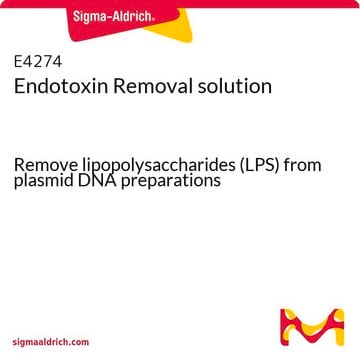X114
Triton™ X-114
laboratory grade
Synonym(s):
(1,1,3,3-Tetramethylbutyl)phenyl-polyethylene glycol, Polyethylene glycol tert-octylphenyl ether
About This Item
Recommended Products
grade
laboratory grade
Quality Level
description
non-ionic
mol wt
average mol wt 537
composition
t-Oct-C6H4-(OCH2CH2)xOH, x = 7-8
refractive index
n20/D 1.488 (lit.)
CMC
0.2 mM (20-25°C)
transition temp
pour point ~−9 °C
cloud point 23 °C
density
1.058 g/mL at 25 °C (lit.)
HLB
12.4
SMILES string
CC(C)(C)CC(C)(C)c1ccc(OCCOCCOCCOCCOCCOCCOCCO)cc1
InChI
1S/C28H50O8/c1-27(2,3)24-28(4,5)25-6-8-26(9-7-25)36-23-22-35-21-20-34-19-18-33-17-16-32-15-14-31-13-12-30-11-10-29/h6-9,29H,10-24H2,1-5H3
InChI key
HNLXNOZHXNSSPN-UHFFFAOYSA-N
Looking for similar products? Visit Product Comparison Guide
General description
Application
- To remove endotoxin from solutions of protein using phase separation technique
- In the extraction and purification of DNA from endotoxin
- In the biphasic extraction of lipoproteins from bacterial cell wall
- As a non-ionic detergent with a low cloud point (23 °C) enabling protein solubilization with phase-partitioning of hydrophilic from amphiphilic proteins
Legal Information
Signal Word
Danger
Hazard Statements
Precautionary Statements
Hazard Classifications
Acute Tox. 4 Oral - Aquatic Acute 1 - Aquatic Chronic 1 - Eye Dam. 1 - Skin Irrit. 2
Storage Class Code
10 - Combustible liquids
WGK
WGK 3
Flash Point(F)
483.8 °F - closed cup
Flash Point(C)
251 °C - closed cup
Personal Protective Equipment
Choose from one of the most recent versions:
Certificates of Analysis (COA)
Don't see the Right Version?
If you require a particular version, you can look up a specific certificate by the Lot or Batch number.
Already Own This Product?
Find documentation for the products that you have recently purchased in the Document Library.
Customers Also Viewed
Articles
GPI Anchored Glycoproteins
GPI Anchored Glycoproteins
GPI Anchored Glycoproteins
GPI Anchored Glycoproteins
Our team of scientists has experience in all areas of research including Life Science, Material Science, Chemical Synthesis, Chromatography, Analytical and many others.
Contact Technical Service










